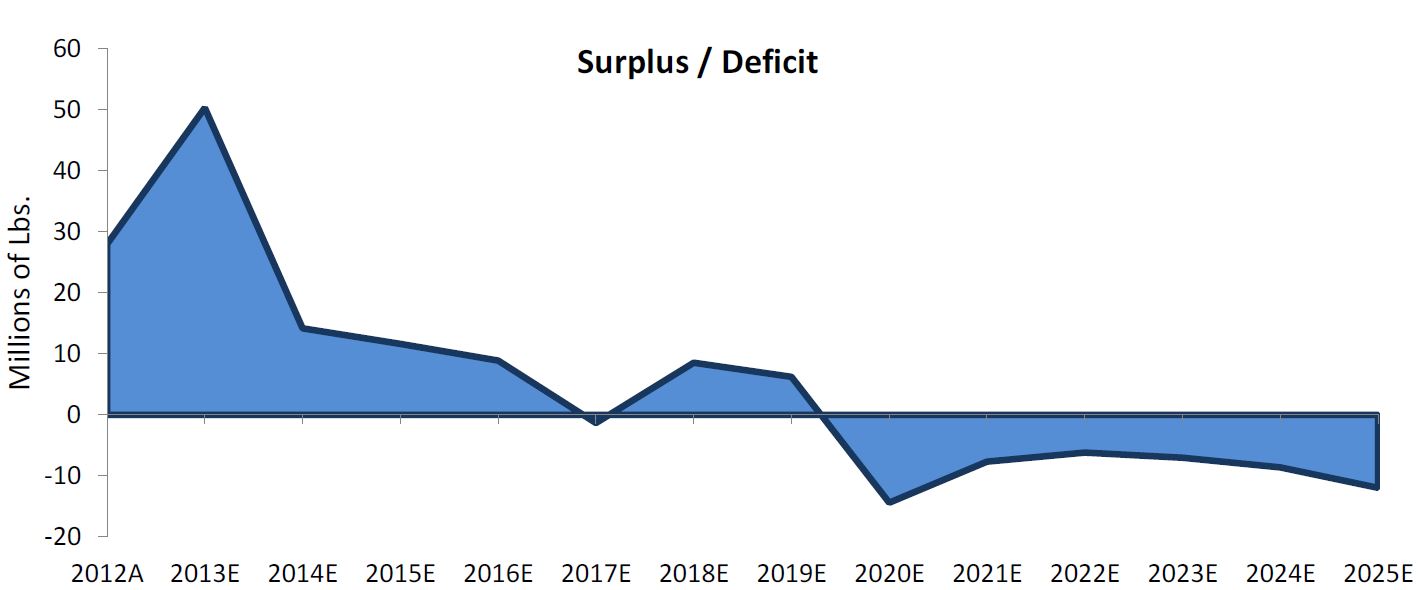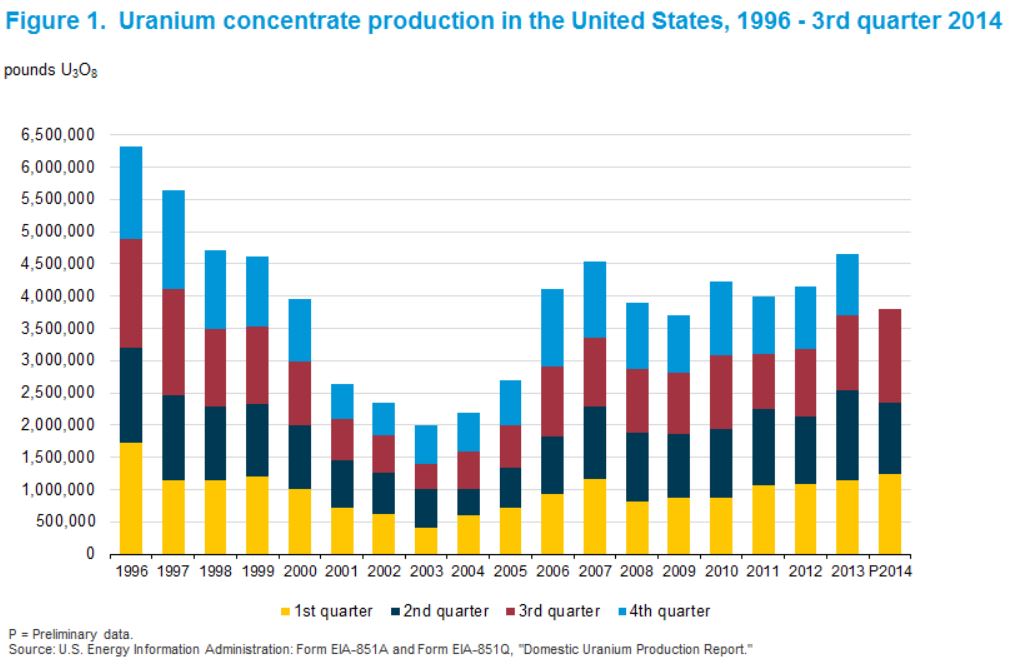Global Uranium
The International Energy Agency (IEA) annual World Energy Outlook (WEO) 2014 report projects global energy trends through to 2040.
Some interesting predictions:
Global energy demand is expected to grow by 37% by 2040.
Electricity demand is expected to increase by almost 80% over the same period with some 7,200 gigawatts (GWe) of capacity needing to be built to keep pace with increasing electricity demand and fleet retirements.
Energy demand growth will be led by China until the mid-2020s, with India then replacing China as the main energy consumer out to at least 2040.
The WEO 2014 report also states there were 437 operating nuclear reactors with total installed capacity of 377,728 MWe (fuel consumption per GWe is 192 tonnes U3O8 ) accounting for 11% of global electricity generation.
According to the IEA nuclear’s share of electricity generation increases to 12% with total capacity increasing 60% to 624 GWe by 2040 this despite 200 reactors are expected to be retired by that time.
The largest increases in nuclear energy generation are expected in China, India, South Korea, and Russia. The number of countries operating reactors is expected to increase from 31 in 2013 to 36 in 2040.

“Industry experts project that, given the number of new reactors planned and the world-wide growing demand for electricity, the demand for uranium will grow significantly over the next decade…
The World Nuclear Association predicts that by 2020, mined production will account for 90% of global uranium supply, compared to 75% today…
By 2020, China alone will consume the equivalent of one-third of today’s global uranium market. China and Russia have already begun aggressively buying up huge stakes in uranium mining operations around the world in order to stockpile uranium to meet their rising domestic demand.” Virginia Uranium Inc.

Cantor Fitzgerald

Cantor Fitzgerald
Pre-Fukushima, Japan’s nuclear reactors supplied up to 30% of the country’s electricity. Analyst reports predict as many as 19 Japanese reactors will have been restarted by the end of 2016 amounting to roughly 14.5M lbs. of annual U3O8 demand.
Based on the most recent statistics from the World Nuclear Association, there are a total of 253 reactors that are either under construction, or planned around the world. Prior to the Fukushima incident in February 2011, there were only 218 reactors under construction or planned.
Ux Consulting company LLC or UxCo, in its "Uranium Market Outlook - Q1 2014" estimated that by 2030 there will be 609 nuclear reactors in operation worldwide in 41 countries, supplying 588 gigawatts of electricity. UxCo also estimated that uranium demand will grow from 172.1 million pounds of U3O8in 2013 to 265.0 million pounds in 2030.
U.S. Uranium
At the end of September 2014, U.S. uranium concentrate production totaled 3,805,798 pounds U3O8. This amount is just 3% higher than the 3,712,541 pounds produced during the first nine months of 2013.
The U.S.’s 99 operating reactors (with 5 under construction) consume approximately 50 million pounds of uranium each year. However, the U.S. produces less than 5 million pounds and imports over 90 percent of the uranium it uses.

U.S. Energy Information
The Megatons to Megawatts™ Program was a government/industry partnership in which bomb grade uranium from dismantled Russian nuclear warheads was recycled into low enriched uranium (LEU) used to produce fuel for American nuclear power plants. The U.S./Russia Megatons to Megawatts Program ended in 2013.
According to the World Nuclear Association, January 2014:
The Megatons to Megawatts program supplied around 10% of all US electricity over the past 15 years.
The Megatons to Megawatts program supplied 12% of world uranium demand.
Russia and the U.S. signed a new uranium supply contract (in 2011) to replace the soon to be ending Megatons to Megawatts™ Program. A significant part of U.S. reactor fuel will now come from Russia’s commercial enrichment activities, using U.S. supplied feedstock, rather than the down blending of Russian weapons material. This new agreement means US has to source additional new uranium, deliver it to Russia for Russia to enrich, and then buy the resulting LEU.
By 2015, supplies to the USA are expected to be half the level supplied under the prior Megatons to Megawatts Program (the option exists to supply up to the same level), the new program is expected to continue until 2022.
Russia is a major player in the secondary (reprocessing) uranium market. However, with banking sanctions in place (and more being proposed), Russia is being squeezed out of international money markets. On Monday, 26 of January 2015, ratings agency S&P cut Russia's sovereign credit rating to BBB-, just a cut above junk bond status. Moody’s downgraded Russia the proceeding week with the warning that further hits to the Kremlin’s credit rating are on the way. Many are convinced the Russians are going to have an increasingly hard time making fuel deliveries.
“We believe that Russia's financial system is weakening and therefore limiting the Central Bank of Russia's (CBR's) ability to transmit monetary policy. In our opinion, the CBR faces increasingly difficult monetary policy decisions while also trying to support sustainable GDP growth,” S&P analysts.
Building a U.S. Based Uranium Powerhouse
Energy Fuels Inc. (AMEX:UUUU) has recently announced a proposed acquisition of Uranerz Energy Corporation (AMEX:URZ). Under the terms of the all-stock transaction, URZ shareholders receive 0.255 shares of UUUU for ownership of 55% in the combined company, Energy Fuels shareholders will own the remaining 45%.
The transaction is expected to create the largest integrated U.S. focused uranium producer through the combination of in-situ recovery (ISR) in Wyoming’s Powder River Basin (PRB), conventional uranium operations/alternate feed processing operations in the Southwest U.S., and a significant development pipeline of projects located throughout Utah, Wyoming, Arizona and New Mexico.
URZ’s Dennis Higgs, Glenn Catchpole and Paul Saxton have been nominated to the BoD of a new Energy Fuels.
Combined 2015 uranium sales are projected to be ~1MM lbs at $58/lb. The merged company will have a total of six separate uranium supply contracts with terms extending to 2020.
Conclusion
The merger is expected to close in mid 2015following regulatory and shareholder approvals for both companies.
I like this proposed merger for several reasons:
The timing couldn’t be better. I do not consider this a ‘today deal.’ I look at the merger being done today as building for tomorrow the largest integrated uranium production company focused solely on the United States
The uranium market is facing a dramatic supply risk due to low market prices. Analysts are saying the uranium market must recover to $75-$80/pound to incentivize the development of new uranium projects.
The existence of long-term sales contracts provides downside protection
The combined entity has the ability to ramp up production from its existing project portfolio quickly
Is a U.S. based uranium powerhouse on your radar screen?
If not, it should be.
Richard (Rick) Mills
Richard lives with his family on a 160 acre ranch in northern British Columbia. He invests in the resource and biotechnology/pharmaceutical sectors and is the owner of Aheadoftheherd.com. His articles have been published on over 400 websites, including:
WallStreetJournal, USAToday, NationalPost, Lewrockwell, MontrealGazette, VancouverSun, CBSnews, HuffingtonPost, Beforeitsnews, Londonthenews, Wealthwire, CalgaryHerald, Forbes, Dallasnews, SGTreport, Vantagewire, Indiatimes, Ninemsn, Ibtimes, Businessweek, HongKongHerald, Moneytalks, SeekingAlpha, BusinessInsider, Investing.com, MSN.com and the Association of Mining Analysts.
Legal Notice / Disclaimer
This document is not and should not be construed as an offer to sell or the solicitation of an offer to purchase or subscribe for any investment.
Richard Mills has based this document on information obtained from sources he believes to be reliable but which has not been independently verified.
Richard Mills makes no guarantee, representation or warranty and accepts no responsibility or liability as to its accuracy or completeness. Expressions of opinion are those of Richard Mills only and are subject to change without notice. Richard Mills assumes no warranty, liability or guarantee for the current relevance, correctness or completeness of any information provided within this Report and will not be held liable for the consequence of reliance upon any opinion or statement contained herein or any omission.
Furthermore, I, Richard Mills, assume no liability for any direct or indirect loss or damage or, in particular, for lost profit, which you may incur as a result of the use and existence of the information provided within this Report.
Richard does not own shares of Uranerz Energy Corp. or Energy Fuels.
Uranerz Energy Corp. is a paid sponsor of Richard’s site aheadoftheherd.com
This article is not paid for content.
